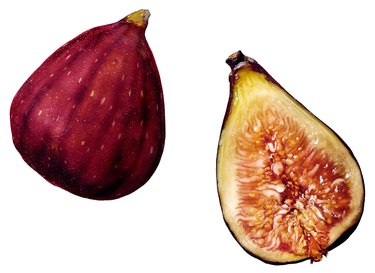
Figs (Ficus carica) are a popular fruit for home orchards because they are more tolerant of adverse conditions than most common fruit trees. They can be grown in U.S. Department of Agriculture plant hardiness zones 7 through 11, though many gardeners also grow figs in containers and bring them indoors in the winter. Figs are easier than most fruit trees to propagate, but they have an unusual approach to flowering, pollination, and seed formation that varies depending on the variety.
Pollination
Video of the Day
Figs require specialized pollination by fig wasps to produce seed. The flowers actually are inside the flesh of what appears to be immature fruit, but actually is like a flower turned inside out. A small hole at the base allows the wasp to enter and fertilize the flowers of female trees with pollen from male trees. The fruit-like flowers of male trees, called capri figs, fall off after releasing their pollen. If pollinated successfully, the flowers of female trees enlarge to become soft and delicious ripe figs.
Video of the Day
Fresh Figs
Not all figs require this specialized type of pollination to form ripe fruit. Most of the fresh figs bought in stores or produced by backyard orchardists have never been pollinated and do not have viable seeds. These are from fig varieties that have been selected for their ability to develop ripe fruit without pollination. In this case, the unusual fig flower grows into a fleshy fruit without the assistance of pollinating wasps.
Dried Figs
Most of the dried figs found in grocery stores are varieties of the "Smyrna" fig. This type of fig requires pollination by fig wasps, which are not native to North America. Commercial orchardists introduce the wasp to pollinate their trees, but because the practice requires specialized knowledge and supplies, it rarely is done by home gardeners. The fruit from pollinated "Smyrna" figs is used for drying because of its high sugar content and the crunchy texture imparted by the seeds.
Propagation
Fruiting figs are propagated by cuttings, whether they are pollinated varieties containing viable seeds or the seedless type. This method of clonal propagation ensures that a new tree will be produced with the same fruiting qualities as the parent. The use of a separate rootstock is not required as is common with other fruit trees.